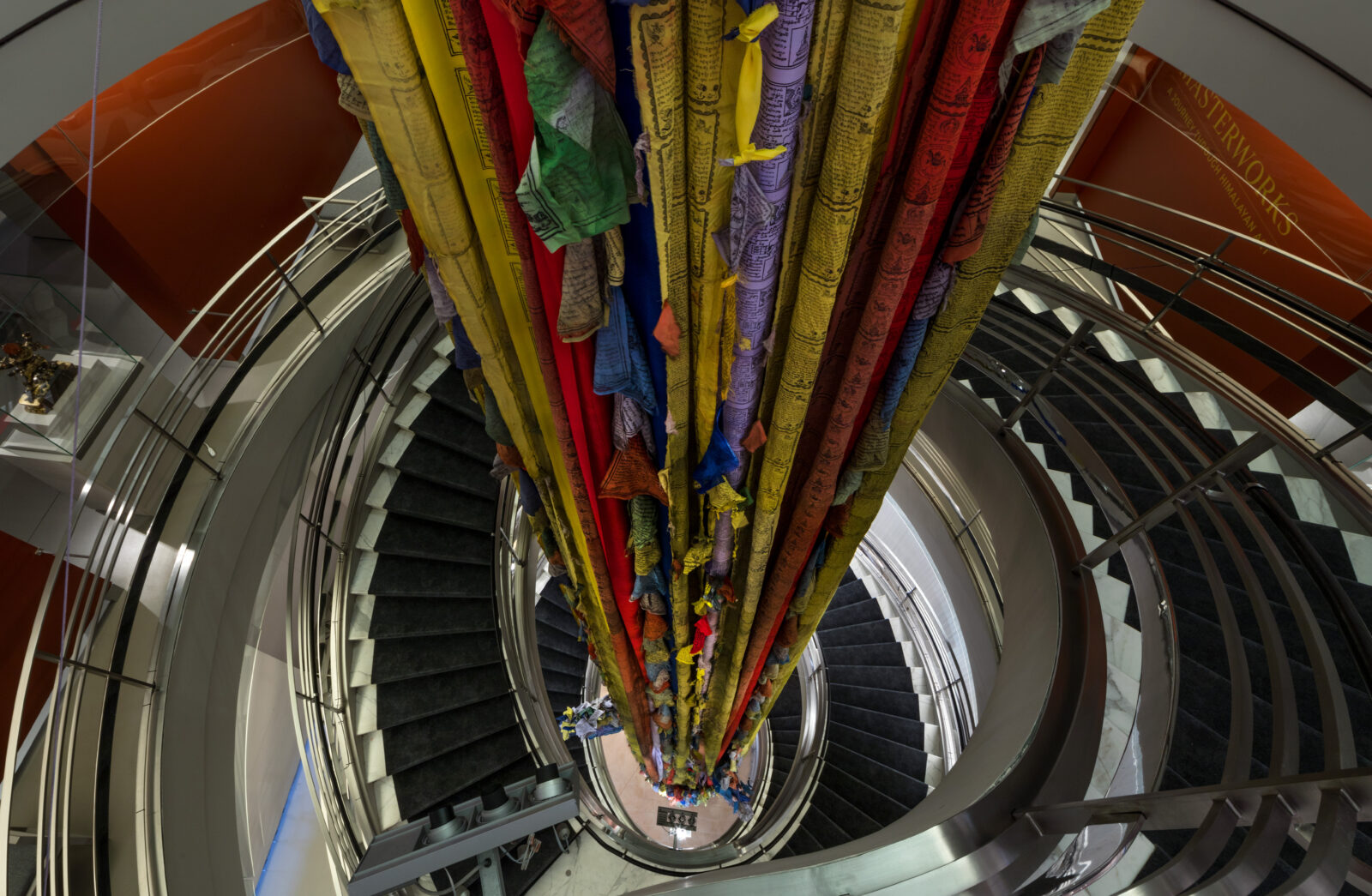
Asha Kama Wangdi, VAST Bhutan; The Windhorse (lungta); 2024; cloth and metal; photo by Dave de Armas

Asha Kama Wangdi, VAST Bhutan; The Windhorse (lungta); 2024; cloth and metal; photo by Dave de Armas
What is it about time that makes us feel so scared?
Is it the moments when time feels like it is slipping away? We want to make the most of it. Or is it when time feels like it is dragging, exhausting, and never ending? We want this time to disappear.
Then there are moments you just want time to stand still, like the time I looked up at the Rubin Museum’s spiral staircase and found myself caught in a swirl.
Swirling with all that has happened and is happening in this space called the Rubin.
I arrived at the Museum in February 2024 with my life’s mentor, Asha Kama Wangdi, and the VAST Bhutan (Voluntary Artists Studio, Thimphu) team on a simple mission to release the windhorses—known as lungta—in the spiral staircase as part of the exhibition Reimagine: Himalayan Art Now.
When the planning for this art installation started in late December 2022, the mood among us at VAST Bhutan was less about the importance of having Bhutanese visual art occupy center stage in a major city in the United States and more about our hope to present Asha Kama’s pure intentions to invoke the basic goodness in all of us through the process of releasing the lungta, as the windhorses symbolize our own inner energies. Each horse dons a color representing an element: red for fire, blue for space, green for water, yellow for earth, and white for air.
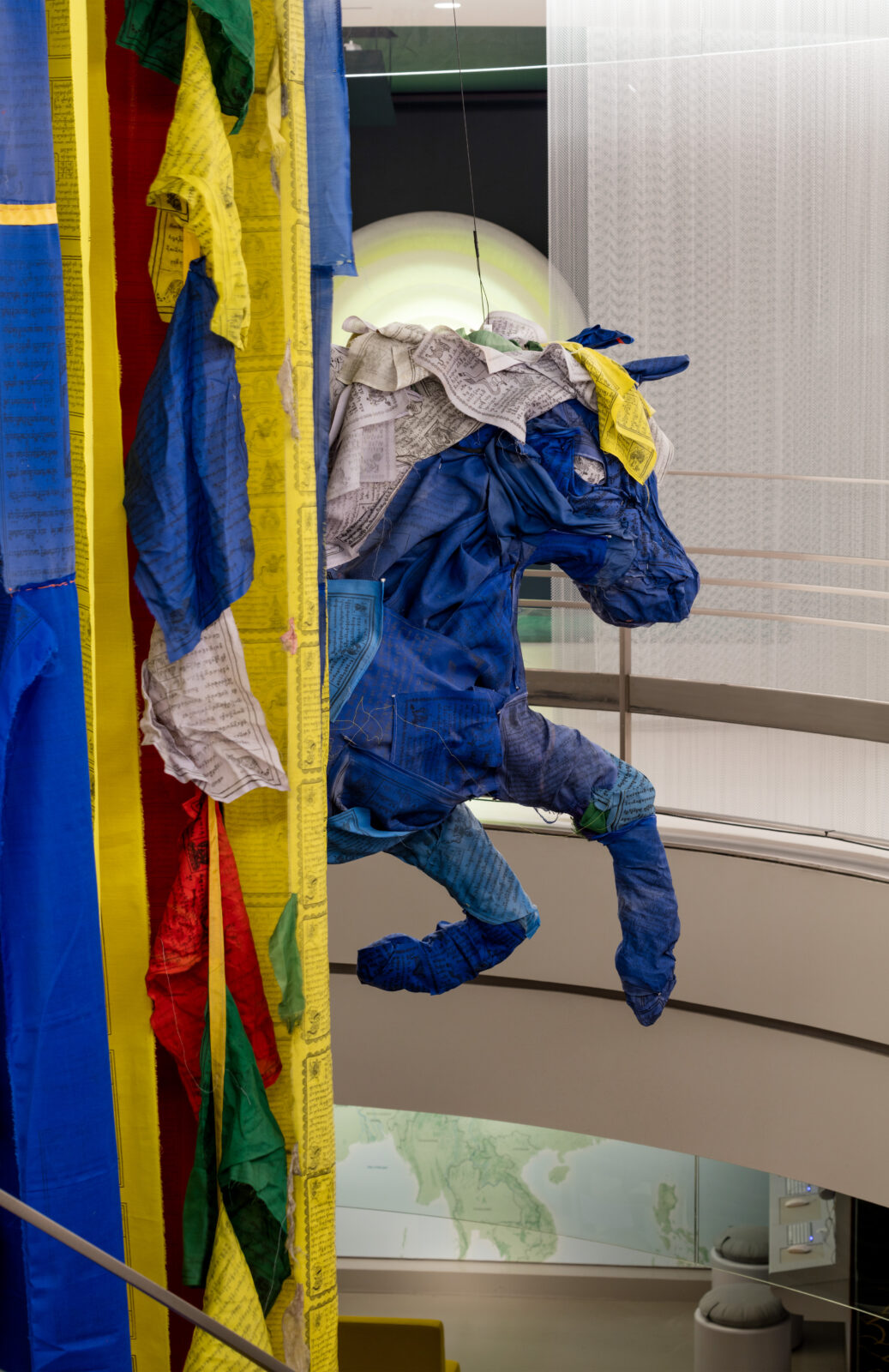
Asha Kama Wangdi, VAST Bhutan; The Windhorse (lungta); 2024; cloth and metal; photo by Dave de Armas
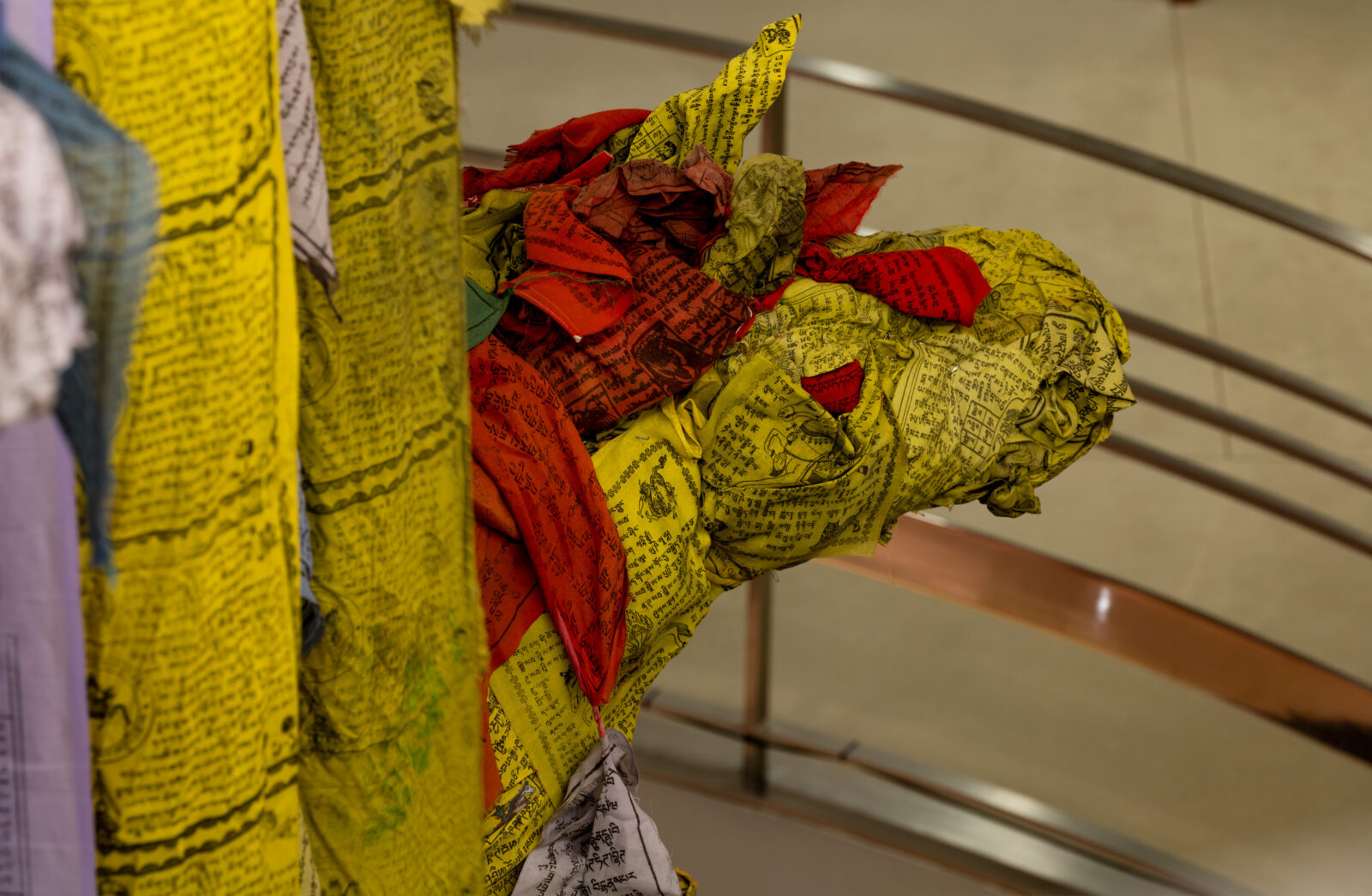
Asha Kama Wangdi, VAST Bhutan; The Windhorse (lungta); 2024; cloth and metal; photo by Dave de Armas
With this purpose, we came to Rubin, and as days progressed, we stitched, rolled, and let flow the prayer flags salvaged from the hilltops of my beloved city of Thimphu, bearing all the beauty and the flaws of the faded prayer flags. We used the prayer flags to bring form and shape to the five skeleton frames of the horses, giving them the appearance of having been just released. While we built momentum and worked in tandem with our breath, a connection grew organically between the team, the surrounding people, and the space itself.
I believe this feeling of deep connection with everyone and everything around us was the release of our own windhorses. From the very beginning, there was a consistent interplay of our intention, devotion, and action that perhaps opened up or aligned the five elements to create a feeling of oneness.
The day the installation was hauled up the center of the spiral staircase to the oculus was a show by itself. As the horses were carefully and slowly raised, the horses synced up with the falling, flowing prayer flags, and each one amusingly started showing a personality of its own.
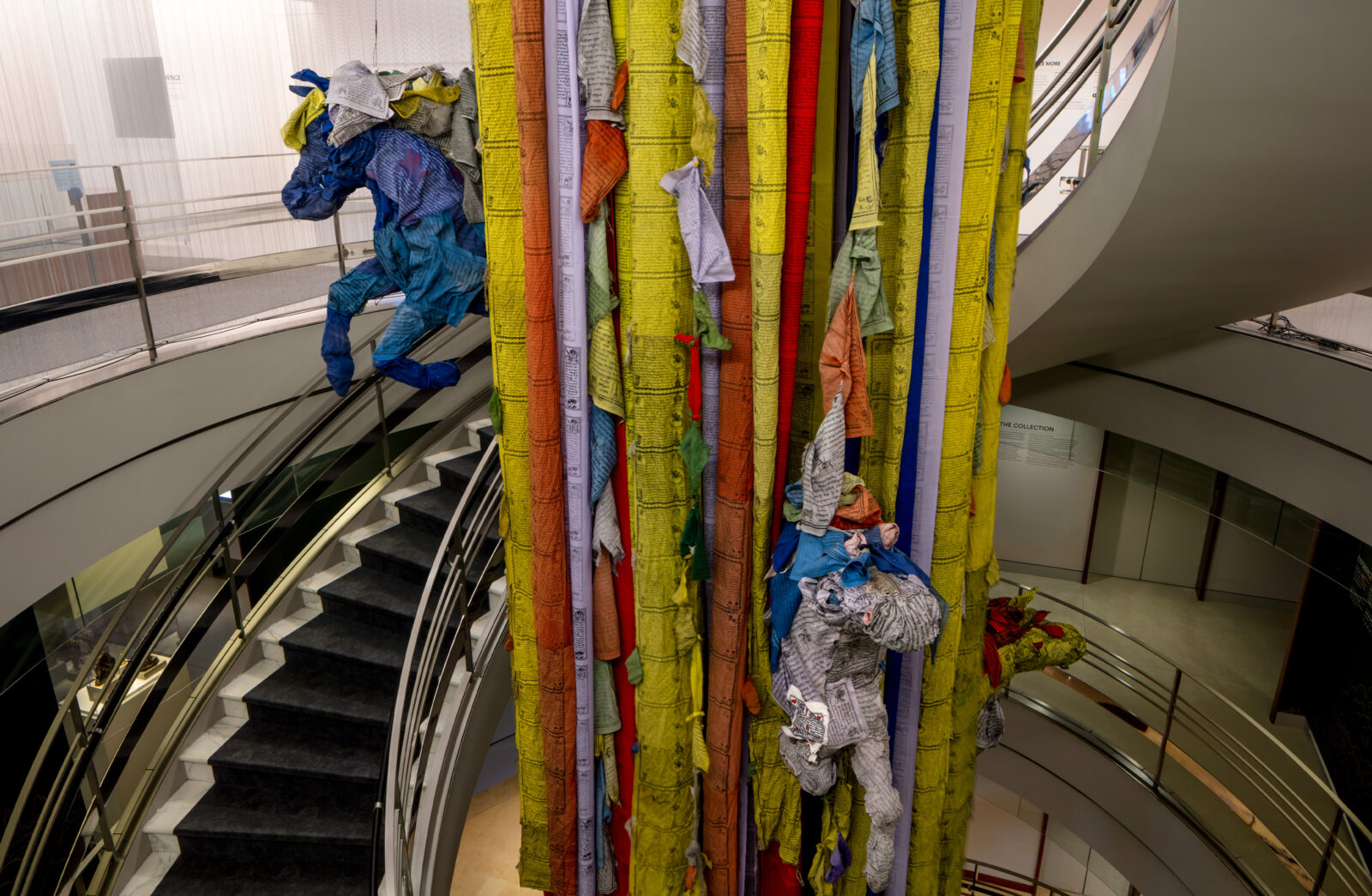
Asha Kama Wangdi, VAST Bhutan; The Windhorse (lungta); 2024; cloth and metal; photo by Dave de Armas
As this spectacle unraveled before my eyes, it dawned on me that despite all the grandiosity, the installation was fated to be dismantled and eventually brought down. It was this moment when I felt the reality of Rubin Museum closing its New York City space and felt like time was closing in.
This was the time—I wanted it to be still!
Time was far from still. It took me to these thoughts:
How much time, in the past twenty years, was spent bringing Himalayan art to this space to reach people who wanted to fill their time with this art and its insights.
How many people must have felt connected to their roots, especially those who are from the Himalayan region but have never been home.
How many people have stood here intrigued with the fluidity of forms and mysterious figures of the sacred.
How many people working here have unsaid emotions, knowing that this tangible space that brought meaning to their work, will soon be no more.
That day, with all these thoughts, I went up the staircase and into the Tibetan Buddhist Shrine Room, where I touched a piece of the Rubin’s foundation stone, placed as part of a sound art installation piece by artist John Tsung. The stone is connected to the sounds of prayers.
The prayers said:
Gone. Gone. Gone ashore. Gone beyond. So be it!
I prayed, contemplating on these prayers, then left to spend my remaining days as an artist-in-residence at the Rubin.
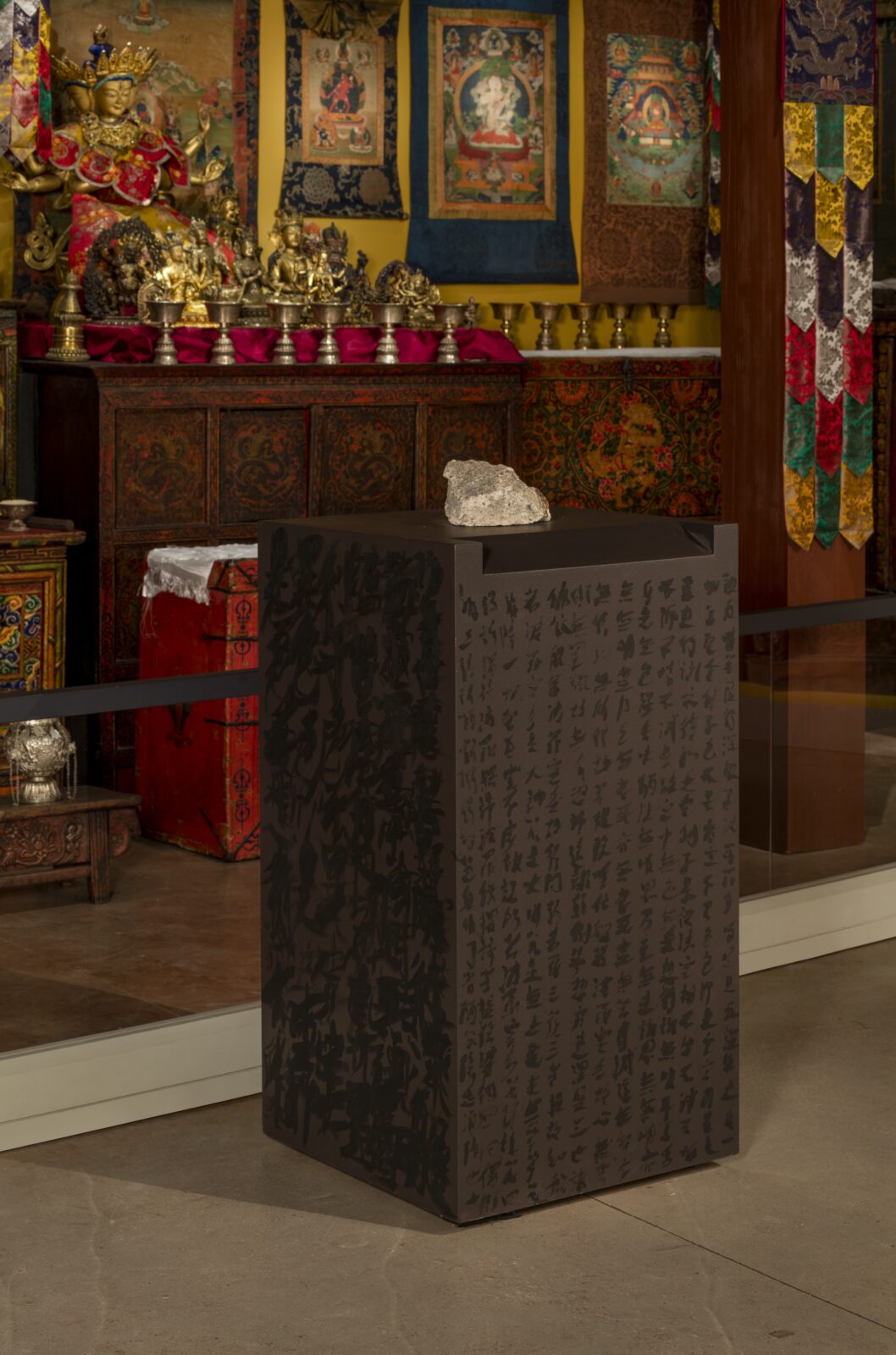
John Tsung; 神代 (Divine Generation); 2024; piezo, cable, speakers, transducers; courtesy of the artist; Photo by Dave De Armas
Under this spiral staircase I met Jose, the custodian, and under this staircase I met Jorrit, the director. In the days in between Jose and Jorrit, I shared my time with Michelle, Brianne, Tashi, Stephanie, Christina, Sarah, Kirstin, Bryce, Danielle, Haena, Elena, Ruth, Atul, Kevin, Albert, Tim, Devon, Nick, Becky, Anthony, and many more.
All of them are grappling with the tides of change headed toward their space. The feelings of the ones who shall stay ashore and the ones who shall be pulled back with the tide towards the vast unknown share in same wish, in the depths of it all, for one another, at shore and away, to be okay.
As much as I spent bits and pieces of my time here in this swirling space with the art and artifacts, the most meaningful part of my residency was the time spent engaging with the people who, despite being in the midst of a challenging transitional period, showed incredible kindness to me and a willingness to embrace, teach, and learn. I truly felt connected.
The connection I feel to the people of Rubin and the Rubin as a space is the result of this journey of the lungta art installation. This journey was a pilgrimage, and we were pilgrims who subconsciously released our windhorses in the process. The process was the purpose.
Buddhists believe time and space do not exist. I must confess that although I am a Buddhist, as long as I am living in this form I shall soak into my consciousness and create in my substrate a time and space for the grace and dignity the humans of the Rubin Museum manifested time and time again.
May each of our lungta be released. May all at shore and away be okay.
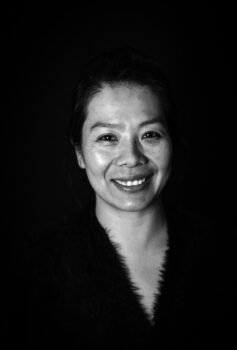
Chimi Zangmo is the chair of VAST Bhutan, a civil society organization that provides artists and youth opportunities to develop artistic talents and explore art as both a vocation and vehicle for community service and self-discovery. Her life has been deeply shaped by her crossing paths with VAST as a teenager. She was a voluntary executive director to the 26-year-old organization from 2016 till 2022.
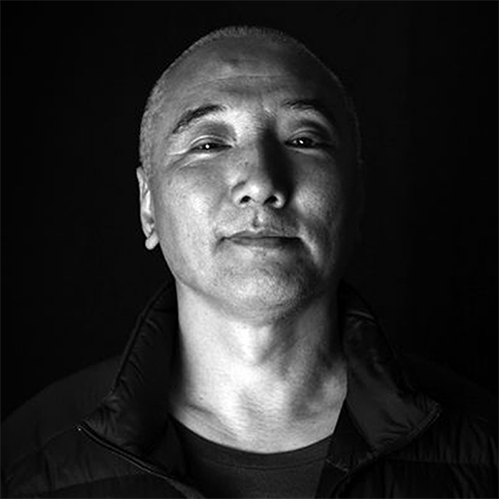

Rubin Museum
150 W. 17th St., NYC
Get the latest news and stories from the Rubin, plus occasional information on how to support our work.